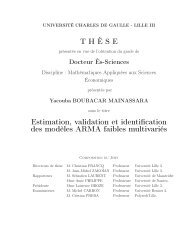A particle-in-Burgers model: theory and numerics - Laboratoire de ...
A particle-in-Burgers model: theory and numerics - Laboratoire de ...
A particle-in-Burgers model: theory and numerics - Laboratoire de ...
You also want an ePaper? Increase the reach of your titles
YUMPU automatically turns print PDFs into web optimized ePapers that Google loves.
Mo<strong>de</strong>l <strong>and</strong> motivation Auxiliary steps Results h = 0: coupl<strong>in</strong>g h = 0: <strong>de</strong>f<strong>in</strong>ition, uniqueness h = 0: <strong>numerics</strong>, existence The coupled problem<br />
...Frozen <strong>particle</strong>: uniqueness, comparison, L 1 contraction.<br />
Theorem (L 1 contraction+comparison, analogous to Kruzhkov <strong>theory</strong>)<br />
Let u0 <strong>and</strong> v0 be two <strong>in</strong>itial data <strong>in</strong> L ∞ (R) <strong>and</strong> let u <strong>and</strong> v be the associated<br />
entropy solutions. Then for all R > 0,<br />
for a.e. t > 0<br />
R<br />
R<br />
(u − v) + (t, x) dx <br />
R+Lt<br />
(u0 − v0)<br />
−R−Lt<br />
+ (x) dx<br />
where L = max{u∞,v∞}. Consequently, if (u0 − v0) + ∈ L 1 (R), we have<br />
<br />
for a.e. t > 0 (u − v)<br />
R<br />
+ <br />
(t, x) dx (u0 − v0)<br />
R<br />
+ (x) dx.<br />
In particular, for all u0 ∈ L ∞ (R), there exists at most one solution <strong>and</strong> the map<br />
S(t) : u0 ↦→ u(t,·) on its doma<strong>in</strong> is an or<strong>de</strong>r-preserv<strong>in</strong>g L 1 contraction.<br />
The proof is straightforward us<strong>in</strong>g<br />
– the Kato <strong>in</strong>equality away from the <strong>in</strong>terface (st<strong>and</strong>ard Kruzhkov)<br />
– the characterization B. (“with traces” ) of entropy solutions<br />
– <strong>and</strong> the dissipativity of Gλ .
















